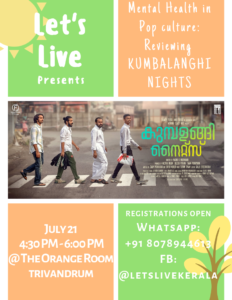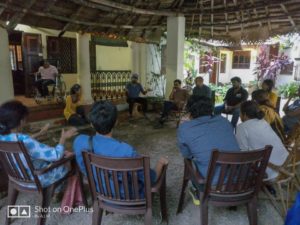Every third Sunday, at The Orange Room, we examine Mental Health in Pop culture. Examples of pop cultural items include film, television programs and commercials, video games, Internet memes, brand names and symbols, sports, slang words and catch- phrases, clothing fads and even food.
We begin the Mental Health in Popular Culture series with Kumbalanghi Nights -a popular culture Malayalam movie which is full of so-called psycho characters.
What happens when a bunch of script writers and movie makers come up with such a movie full of common “uncommon” characters? Are they doing justice to those who actually suffer from various mental health issues? Does the movie spread a positive mental health image? Movies such as this one – does it spread mental health awareness and help reduce the stigma associated with it? Or does it spread misconceptions and add on to the stigma?
- Date: 21 July 2019 | 4:30 PM to 6 PM
- Venue: The Orange Room, Trivandrum
- For registration, contact
- Whatsapp: +91 8078944613
- Facebook: @letslivekerala
Come, let us discuss openly about how popular culture is affecting the minds of common people.
Event Description
Let’s Live, on July 21st 2019 Sunday, organized its first public outreach event at The Orange Room.
The theme was Mental Health in Pop Culture: Reviewing Kumbalangi Nights.
The purpose of the outreach events are to fight the stigma and shame associated with mental health challenges as well as to create better understanding about these issues among the general public.
Popular culture, be it cinema, literature, music or art has a tremendous influence among the people and many a time people with mental health challenges are depicted in a poor light in the popular culture. Cinema, being the primary medium of cultural transmission especially among the teenagers and youth, ought to exhibit greater sensitivity and finesse while dealing with themes on mental health.
About 15 enthusiastic participants joined the discussion over tea and snacks. The conversation initially started with movies that influenced each one of the participants. Later we moved into the core topic – Kumbalangi Nights. The main aspect of the discussion was – which family would you choose to live with – Shammi’s family or Saji’s family. In the debate ensued participants who chose each side of the family was critically questioning the other side. While Shammi’s family had only him as “psycho”, the other family was totally dysfunctional with characters having mood swings, depression, suicidal ideation, substance abuse, abandonment issues etc. Still half of the participants chose to be in such a family set up because of lack of power structure/ hierarchy that existed in that house. The other half stayed with Shammi on the argument that his family is realistic and safe barring the psycho behavior of Shammi that was dramatised towards the end of the film.
Kumbalangi Nights, the Malayalam movie released in 2019, stands out as an iconic movie that upholds the pop culture while at the same time subverting many of the stereotypes associated with family, masculinity and patriarchy. The main characters (Saji, Bonny, Shammi, Franky) represents different strands of masculinity, all of whom can be aggressive at times but becomes too vulnerable at other times. While Shammy is a quirky character displaying toxic masculinity and psychotic behavior, Saji is thoroughly depressed and prone to suicide ideation. Even the family is not the typical heterosexual family where all the members are connected by blood relations. In Shammi’s family, there is safety and protection for the female members and it works as a cohesive unit till the first half. The other family of the four brothers is highly disjointed and dysfunctional where the elder brothers indulge in alcoholism and brawl daily and the household chores are carried out by the youngest brother. The juxtaposition of these families brought forth the view that family ambience and dynamics of relationships has a big influence in shaping the character and personality traits. Shammi was portrayed as a sinister psychotic killer so as to dramatise the toxic masculinity that is inherent in many of us. The film’s crew deserve due credit for creating a story line and plotting a narrative that disturbs and disrupts the conventional cinematic experience of a predominantly male crowd that throngs the movie halls.
Thank you all for your support and participation.

